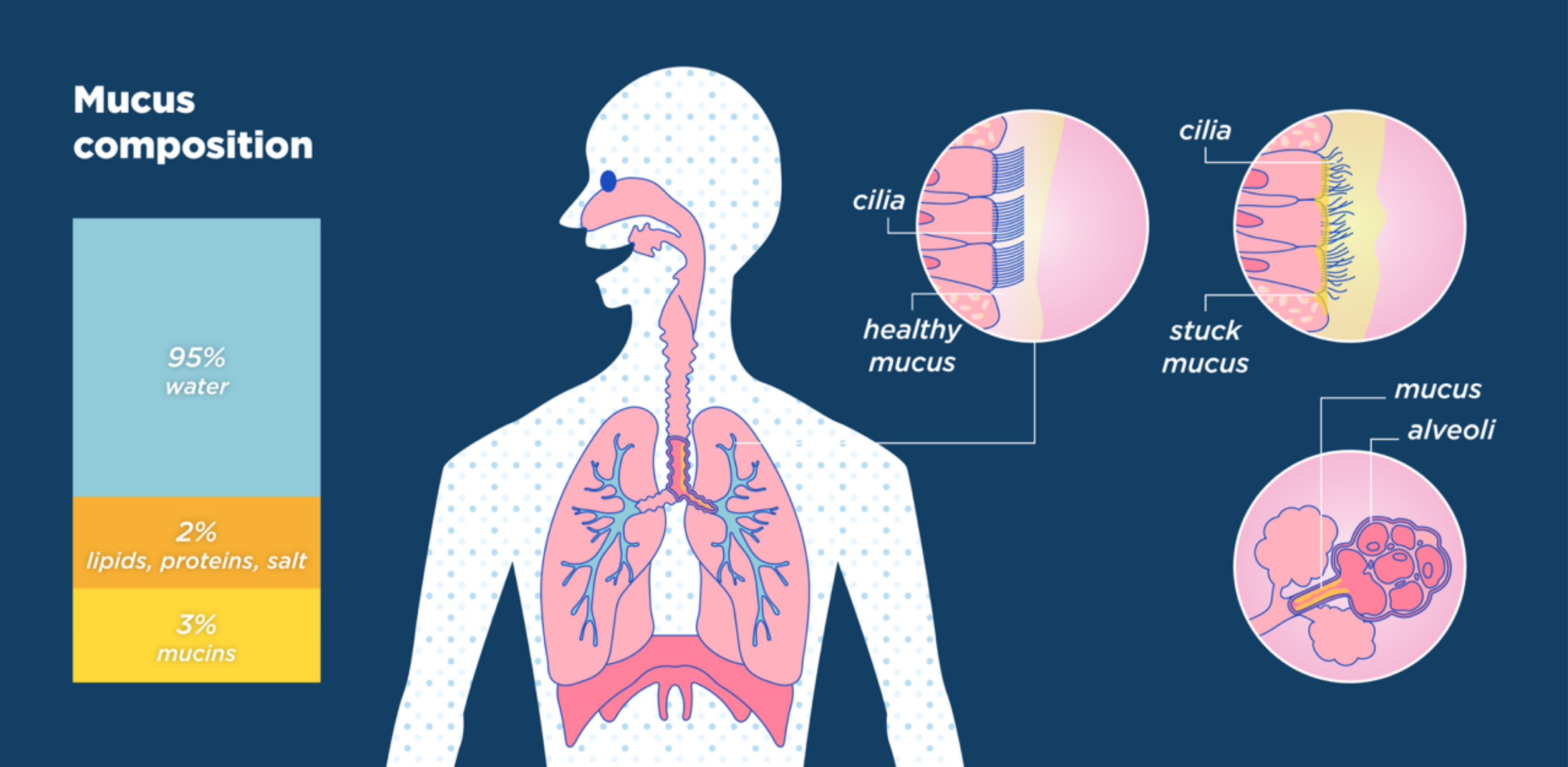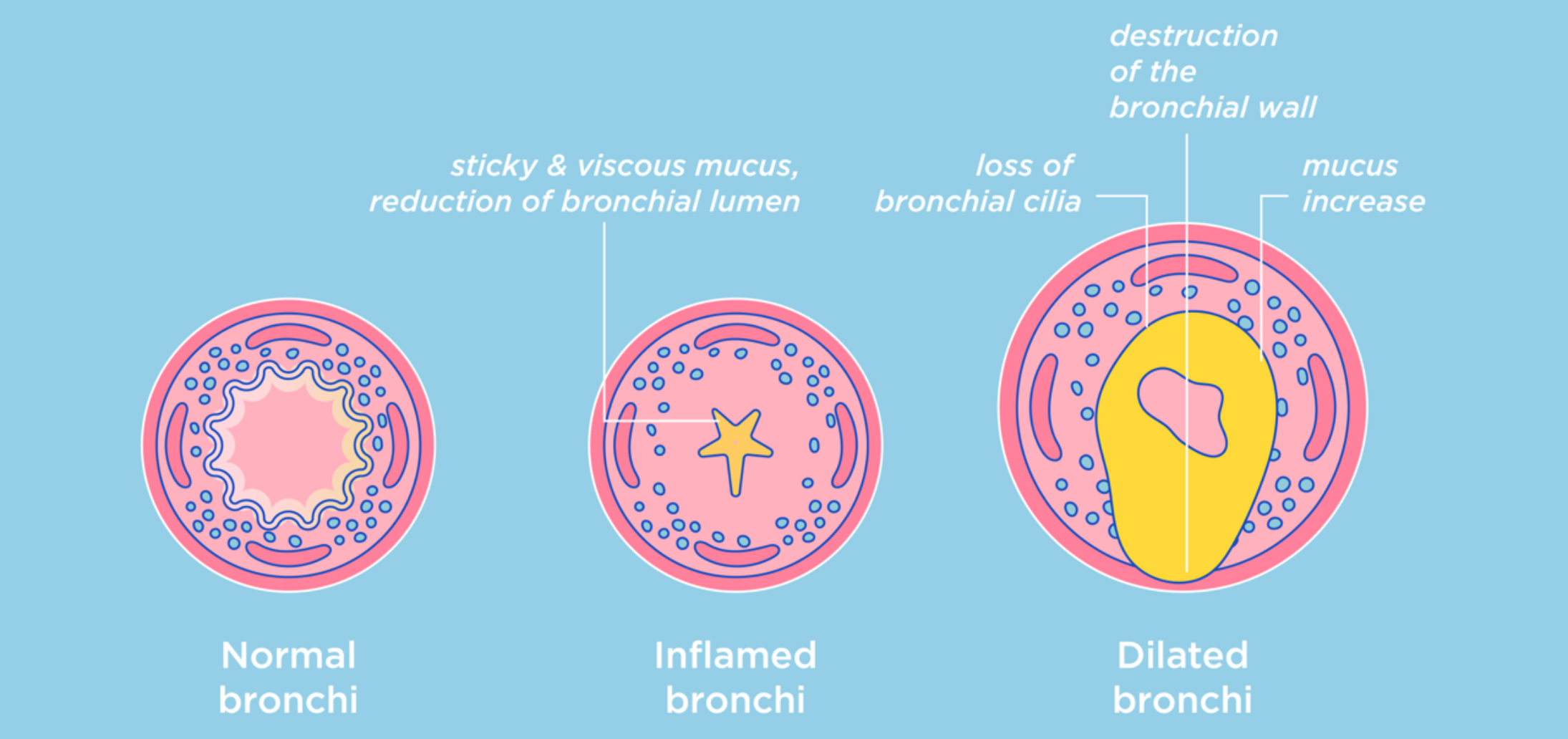What is bronchial mucus?
“The importance of getting airway secretions right: not too runny, not too thick; not too wet, not too dry”

Bronchial mucus is a complex viscoelastic gel that lines the surface of the bronchi and covers an area of 400m2 in the lungs, equivalent to two tennis courts. It acts as a lubricant, air humidifier, and protective agent, representing a barrier against infection. This is therefore a normal secretion, essential to the correct functioning of the organs. Bronchial mucus is secreted by two types of cells: the caliciform cells on the surface of the bronchial epithelium present in the healthy subject from the large bronchi to the preterminal bronchioles (generations 2-16*) and the seromucous glands found mainly in the proximal bronchi (generations 2-7*). Mucus is composed of 95% water, 2% lipids, proteins and salt, and 3% mucins. Mucins are polymers of glycoproteins that form a structured network that captures and retains water. This network ensures the gelation of mucus and gives it a certain plasticity allowing to modify its biophysical properties. *The bronchial tree has a total of 23 generations.
I want to know moreWhy is my mucus stuck into my lungs?
“Healthy mucus vs. Pathological mucus”

Mucus production and cough are important for airway defense and protection of the lower respiratory tract against irritations. However, excessive mucus and excessive cough are related to a number of complications. In a healthy subject, the bronchial mucus is produced mainly in the proximal respiratory airways (bronchi > 2mm of diameter) by the sero-mucous glands and the goblet cells. Chronic lesions of the bronchial epithelium in chronic pulmonary pathologies cause an increase in the volume and/or the number of mucus-producing cells in the proximal and peripheral bronchi. This remodelling of the bronchial epithelium leads to pathologic hypersecretion of mucus in all of the bronchial tree, promoting stagnation and/or obstruction of the airways and leading to a cycle of chronic inflammation and recurrent infections (pulmonary exacerbations).
I want to know moreIf you have one of the following chronic lung conditions, you may suffer from stagnant and/or excessive mucus in your lungs :
- Dilatation of bronchi or Bronchiectasis
- Chronic Obstructive Pulmonary Diseases (COPD)
- Chronic Bronchitis
- Severe Asthma
- Cystic Fibrosis
- Primary Ciliary Dyskinesia
- Post/Long Covid-19
- Etc.
Why is it so important to mobilize and clear bronchial mucus when I suffer from chest congestion?

The persistence of abundant pathological mucus in the bronchial airways significantly alters the pulmonary function and quality of life. It contributes to the worsening of respiratory symptoms (chronic cough, sputum, respiratory discomfort, etc.). In addition, it promotes respiratory infections, inflammation and the development of the disease. It is therefore very important to regularly eliminate these accumulated secretions in order to regain satisfactory respiratory comfort, as well as to hinder the development of the disease. Standard practices calls for efforts to clear secretions from the lungs. In this regard, Airway Clearance Therapies are essential.
I want to know moreHow can Simeox help in easily and comfortably clearing my bronchial mucus?
“Simeox acts on mucus rheology and mechanically liquefies bronchial mucus to facilitate its mobilization”

It is now well known that bronchial mucus is a viscoelastic gel, and thixotropic: when a stress is applied to it, mucus accumulates energy and begins to flow like a liquid. When this stress is stopped, the flow also stops and the mucus returns to its initial state. For viscoelastic gels like bronchial mucus, the flow can only be triggered if the stress exceeds a threshold value. 5 years of research led by PhysioAssist in collaboration with the CNRS* M2P2 laboratory (specialized in the physics of materials) allowed this threshold value to be determined. Simeox, by applying a pneumatic vibratory stress above this threshold value, modifies mucus rheology and promotes its flow. Simeox is used during the exhalation, allowing an efficient and comfortable way to mobilize bronchial mucus in all parts of the lungs. *CNRS: Centre National de la Recherche Scientifique (Scientific Research National Center)
I want to know moreCan I try the Simeox therapy ?
If you are interested in knowing more about Simeox or if you would like to test this therapy, fill in the below form. A Simeox clinical specialist will shortly be in touch.
